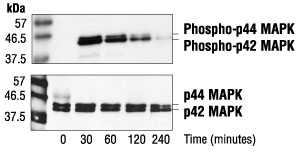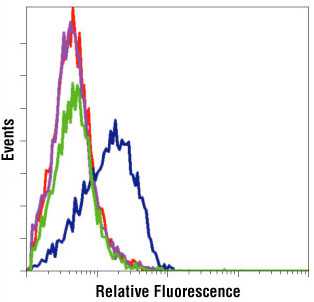Phospho-p44/42 MAPK (Erk1/2) (Thr202/Tyr204) (E10) Mouse mAb
产品名称: Phospho-p44/42 MAPK (Erk1/2) (Thr202/Tyr204) (E10) Mouse mAb
英文名称: Phospho-p44/42 MAPK (Erk1/2) (Thr202/Tyr204) (E10) Mouse mAb
产品编号: 9106S
产品价格: null
产品产地: 美国
品牌商标: cellsignal
更新时间: null
使用范围:
- 联系人 :
- 地址 : 北京市海淀区清河安宁庄东路海洋出版社院内1号楼一层(银海洋宾馆院内)
- 邮编 : 100085
- 所在区域 : 北京
- 电话 : 138****4438 点击查看
- 传真 : 点击查看
- 邮箱 : mengzhichengzklm@126.com
Applications Key: W=Western Blotting IP=Immunoprecipitation F=Flow Cytometry
Reactivity Key: H=Human M=Mouse R=Rat Hm=Hamster Mk=Monkey Mi=Mink Dm=D. melanogaster Z=Zebrafish B=Bovine Pg=Pig
Species cross-reactivity is determined by western blot. Species enclosed in parentheses are predicted to react based on 100% sequence homology
Specificity / Sensitivity
Phospho-p44/42 MAPK (Erk1/2) (Thr202/Tyr204) (E10) Mouse mAb detects endogenous levels of p44 and p42 MAP Kinase (Erk1 and Erk2) when dually phosphorylated at Thr202 and Tyr204 of Erk1 (Thr185 and Tyr187 of Erk2), and singly phosphorylated at Tyr204. This antibody does not cross-react with the corresponding phosphorylated residues of either SAPK/JNK or p38 MAP kinase. This antibody may cross-react with an unknown cytoskeletal protein in some cell lines as visualized by immunofluorescence.
Source / Purification
Monoclonal antibody is produced by immunizing animals with a synthetic phosphopeptide corresponding to residues surrounding Thr202/Tyr204 of human p44 MAP kinase.
Western Blotting
Specificity and sensitivity of the Phospho-p44/42 MAPK (Erk1/2) (Thr202/Tyr204) (E10) Mouse mAb: This antibody reacts specifically with as little as 50 pg of phosphorylated MAP kinase and does not cross-react with up to 4 µg of nonphosphorylated MAP kinase by Western blotting.

Western Blotting
Western blot analysis of extracts from FGF treated SK-N-MC cells, using Phospho-p44/42 MAPK (Erk1/2) (Thr202/Tyr204) (E10) Mouse mAb (upper) or control p44/42 MAPK (Erk1/2) Antibody #9102 (lower).

Flow Cytometry
Flow cytometric analysis of Jurkat cells, untreated (red) or PMA-treated (blue) ; and untreated (green) or PMA-treated (purple) following 90-minute CIP treatment, using Phospho-p44/42 MAPK (Erk1/2) (Thr202/Tyr204) (E10) Mouse mAb.

Background
Mitogen-activated protein kinases (MAPKs) are a widely conserved family of serine/threonine protein kinases involved in many cellular programs, such as cell proliferation, differentiation, motility, and death. The p44/42 MAPK (Erk1/2) signaling pathway can be activated in response to a diverse range of extracellular stimuli including mitogens, growth factors, and cytokines (1-3), and research investigators consider it an important target in the diagnosis and treatment of cancer (4). Upon stimulation, a sequential three-part protein kinase cascade is initiated, consisting of a MAP kinase kinase kinase (MAPKKK or MAP3K), a MAP kinase kinase (MAPKK or MAP2K), and a MAP kinase (MAPK). Multiple p44/42 MAP3Ks have been identified, including members of the Raf family, as well as Mos and Tpl2/COT. MEK1 and MEK2 are the primary MAPKKs in this pathway (5,6). MEK1 and MEK2 activate p44 and p42 through phosphorylation of activation loop residues Thr202/Tyr204 and Thr185/Tyr187, respectively. Several downstream targets of p44/42 have been identified, including p90RSK (7) and the transcription factor Elk-1 (8,9). p44/42 are negatively regulated by a family of dual-specificity (Thr/Tyr) MAPK phosphatases, known as DUSPs or MKPs (10), along with MEK inhibitors, such as U0126 and PD98059.
- Roux, P.P. and Blenis, J. (2004) Microbiol Mol Biol Rev 68, 320-44.
- Baccarini, M. (2005) FEBS Lett 579, 3271-7.
- Meloche, S. and Pouysségur, J. (2007) Oncogene 26, 3227-39.
- Roberts, P.J. and Der, C.J. (2007) Oncogene 26, 3291-310.
- Rubinfeld, H. and Seger, R. (2005) Mol Biotechnol 31, 151-74.
- Murphy, L.O. and Blenis, J. (2006) Trends Biochem Sci 31, 268-75.
- Dalby, K.N. et al. (1998) J Biol Chem 273, 1496-505.
- Marais, R. et al. (1993) Cell 73, 381-93.
- Kortenjann, M. et al. (1994) Mol Cell Biol 14, 4815-24.
- Owens, D.M. and Keyse, S.M. (2007) Oncogene 26, 3203-13.
Application References
- Fonseca, B.D. et al. (2011) J Biol Chem 286, 27111-22. Applications: Western Blotting
- Fei, Z. et al. (2011) J Biol Chem 286, 27761-8. Applications: Western Blotting
- Xu, P. and Derynck, R. (2010) Mol Cell 37, 551-66. Applications: Western Blotting
- Feinerman, O. et al. (2008) Science 321, 1081-4. Applications: Flow Cytometry
- Hyduk, S.J. and Cybulsky, M.I. (2002) Alpha4 Integrin Signaling Activates Phosphatidylinositol 3-Kinase and Stimulates T Cell Adhesion to Intercellular Adhesion Molecule-1 to a Similar Extent As CD3, but Induces a Distinct Rearrangement of the Actin Cytoskeleton. The Journal of Immunology 168, 696-704. Applications: Western Blotting
- Zubiaur, M. et al. (2002) CD38 Is Associated with Lipid Rafts and upon Receptor Stimulation Leads to Akt/Protein Kinase B and Erk Activation in the Absence of the CD3-zeta Immune Receptor Tyrosine-based Activation Motifs. The Journal of Biological Chemistry 277, 13-22. Applications: Western Blotting
- Xu, H. and Goldfarb, M. (2001) J Biol Chem 276, 13049-56. Applications: Western Blotting
- Xing, H. et al. (2000) EMBO J 19, 349-58. Applications: Western Blotting
- Bolshakov, V.Y. et al. (2000) Nat Neurosci 3, 1107-12. Applications: Western Blotting
Have you published research involving the use of our products? If so we'd love to hear about it. Please let us know!
